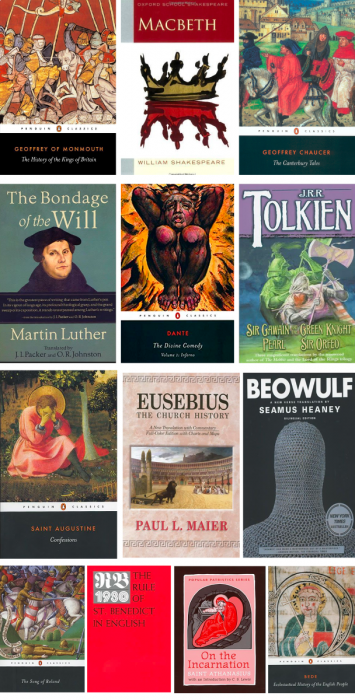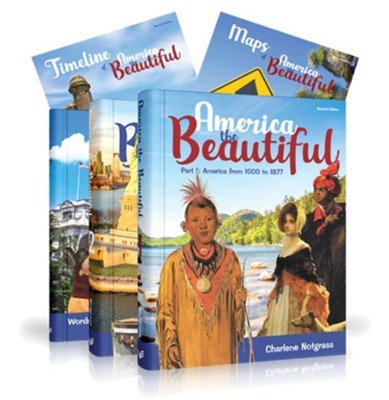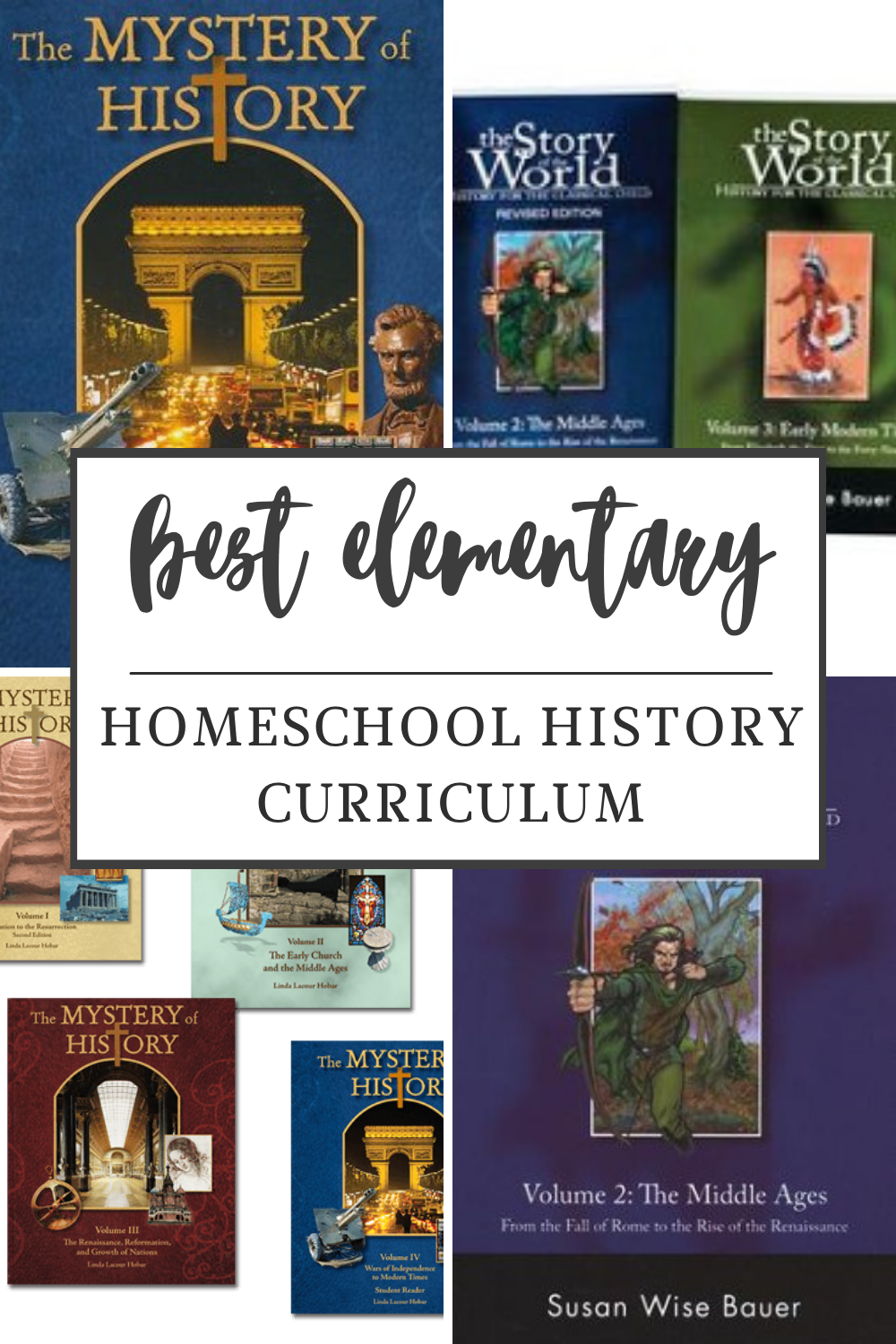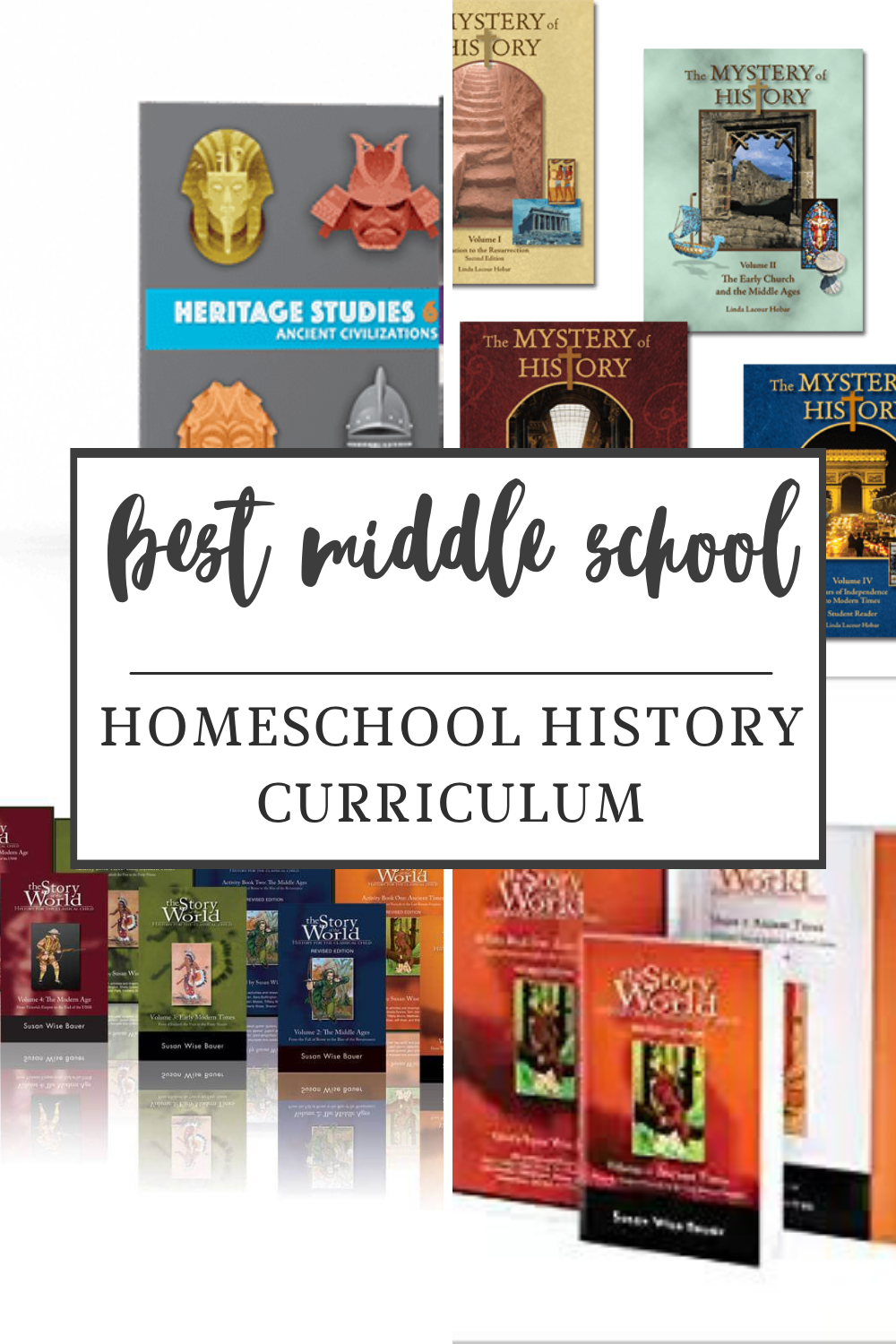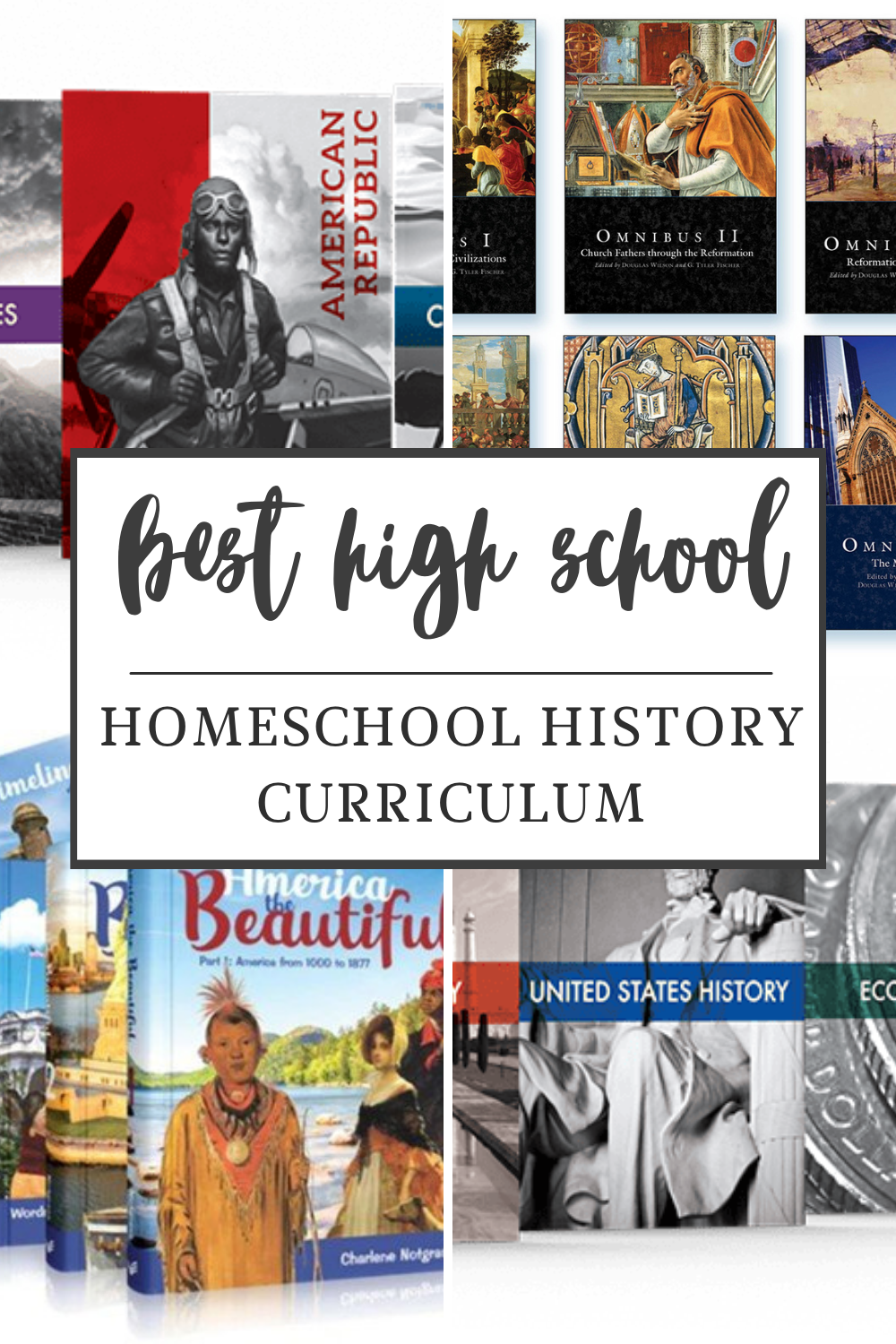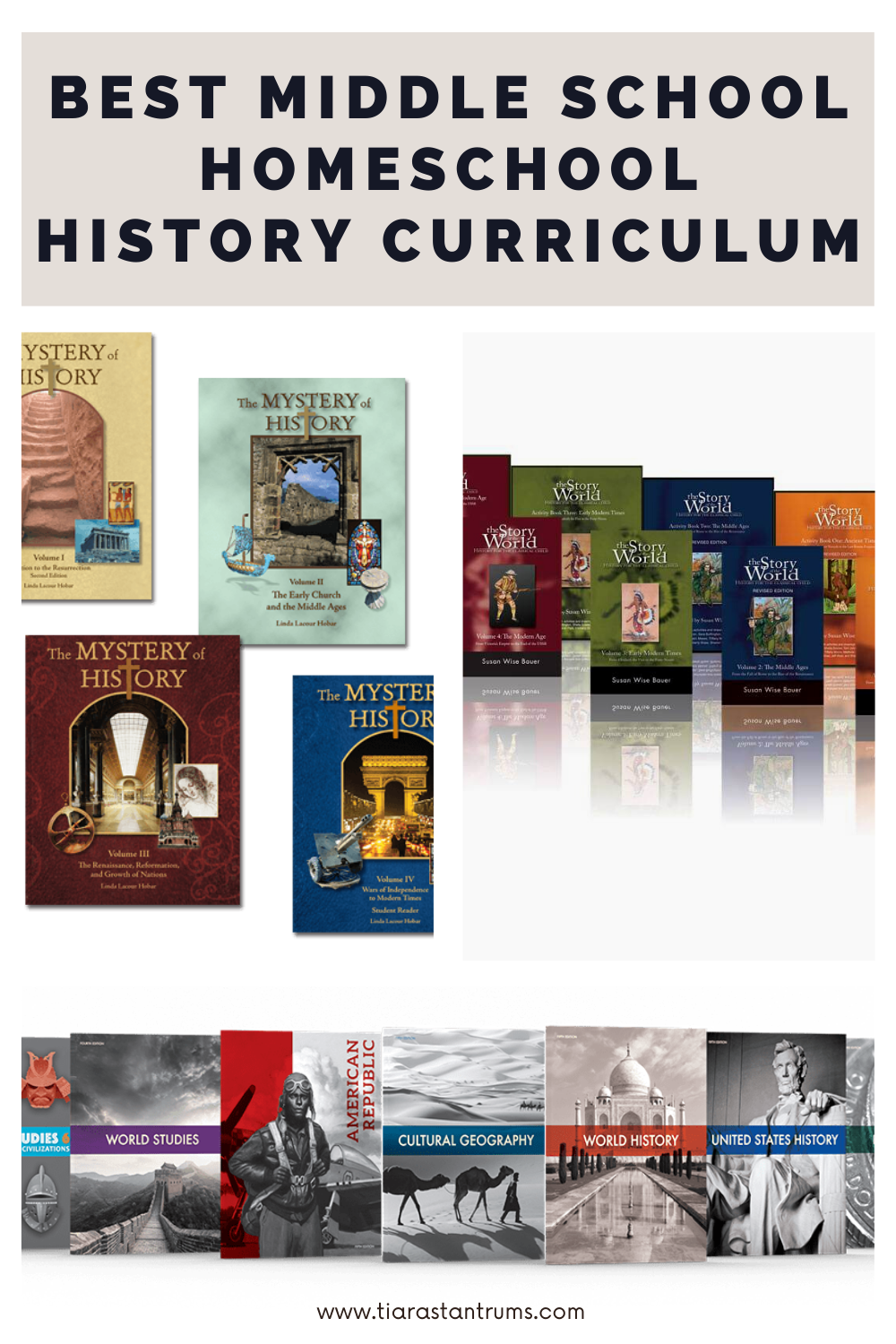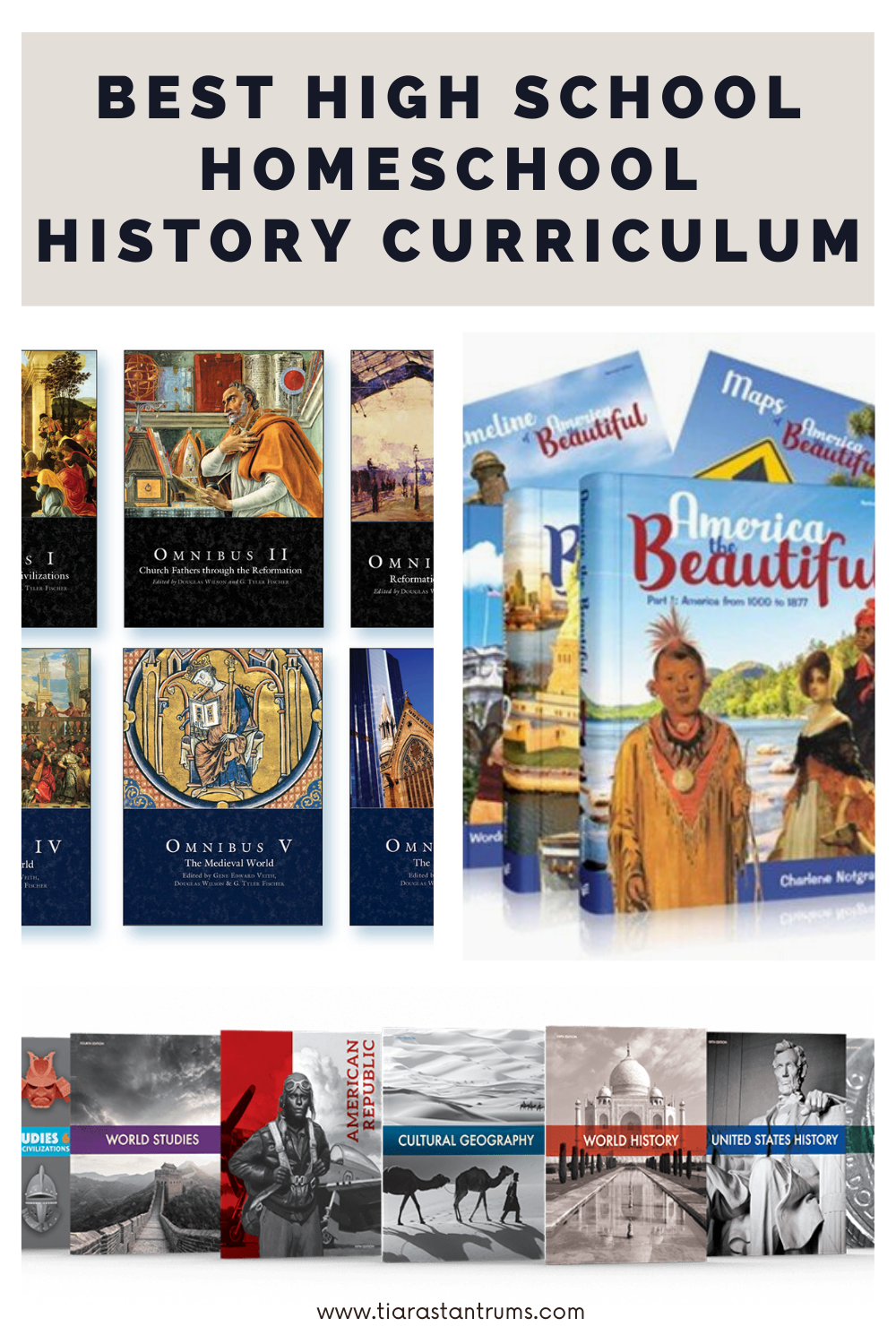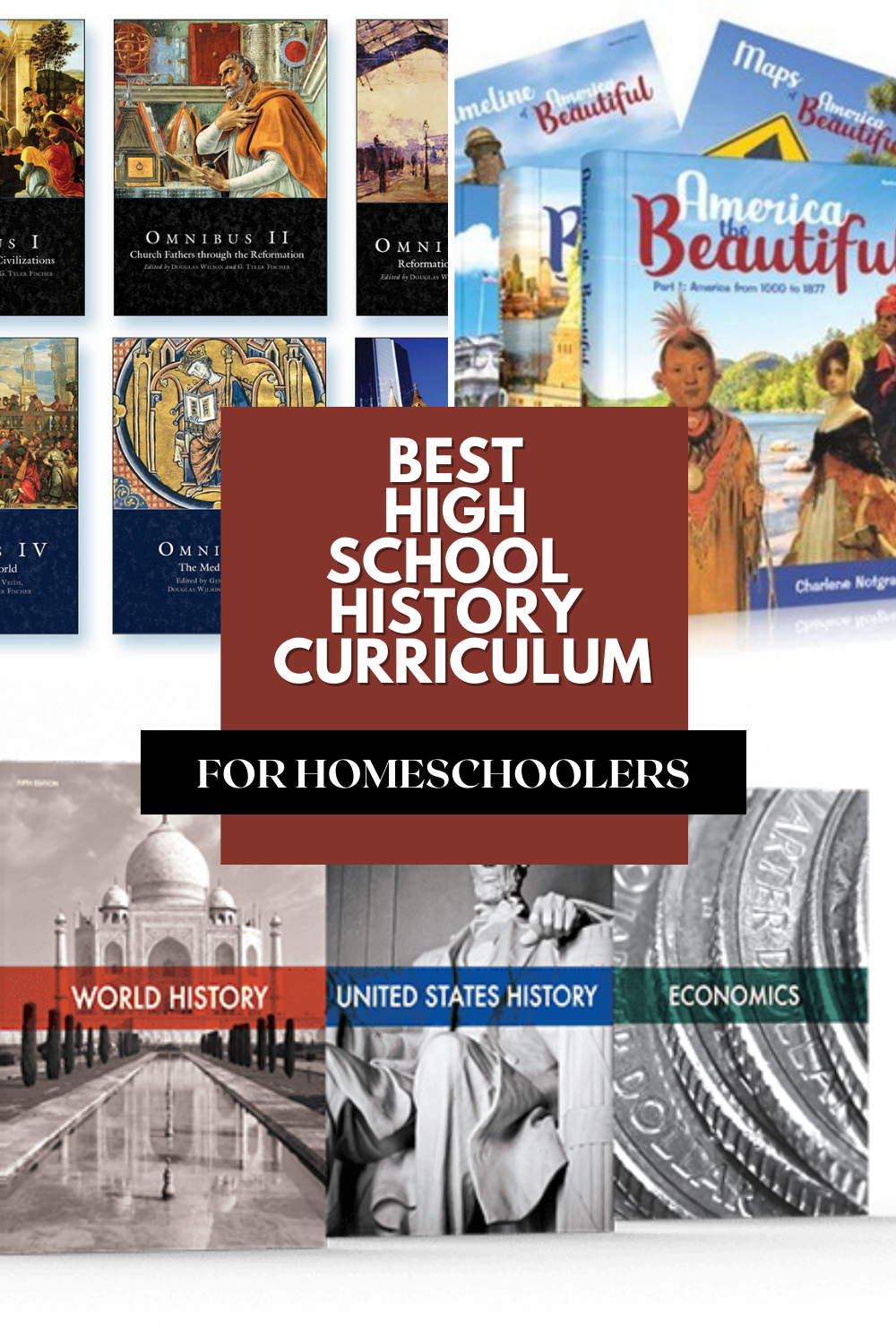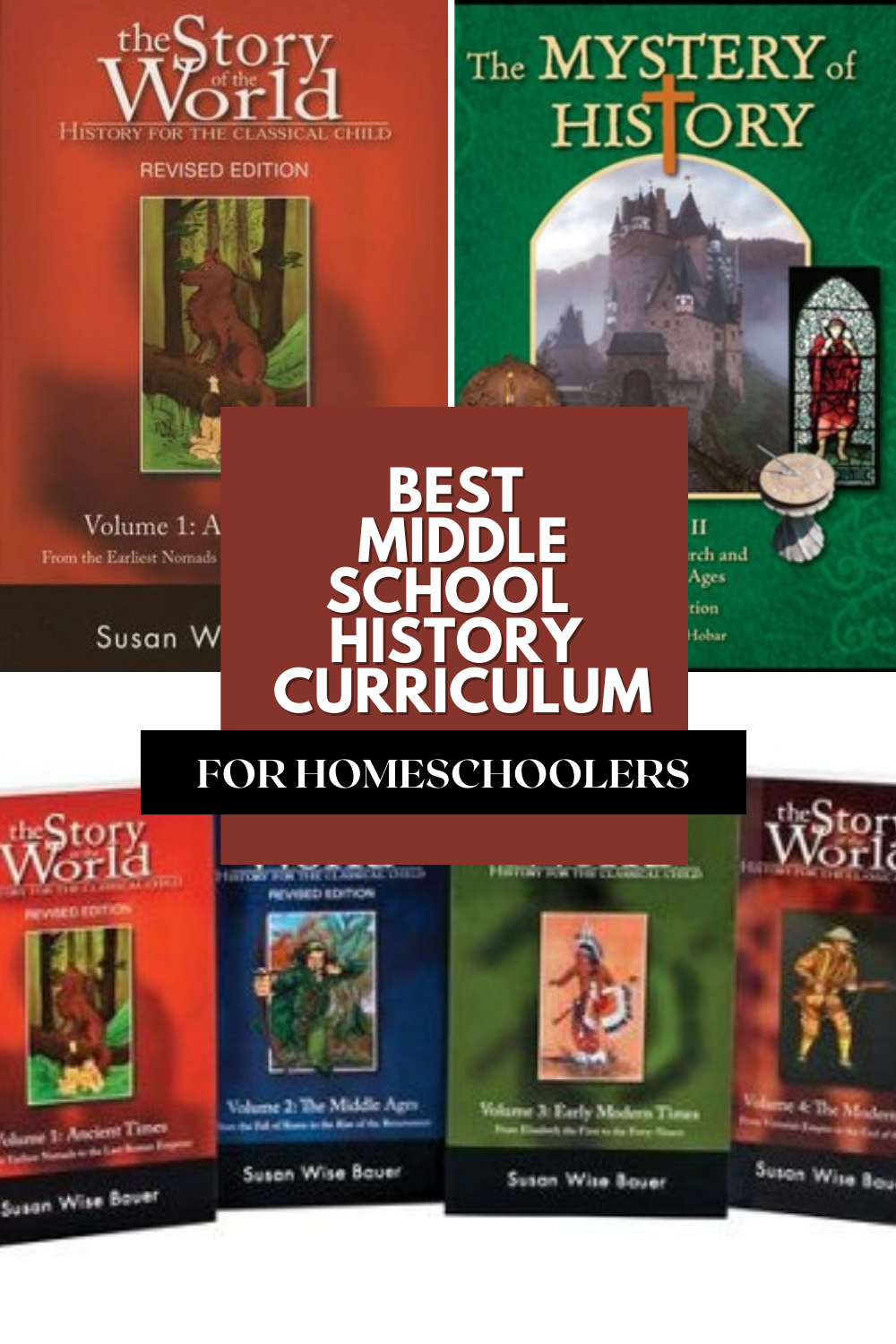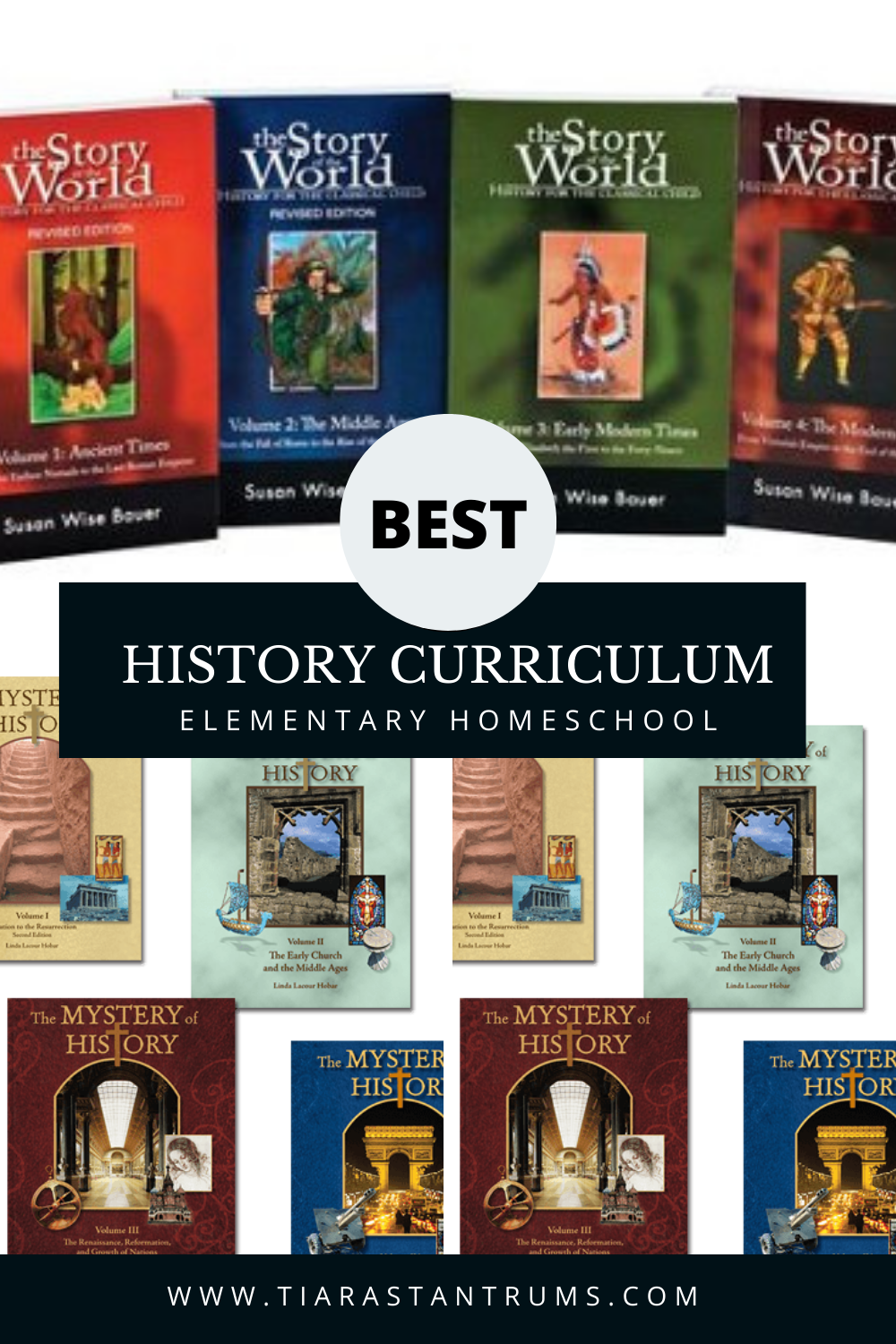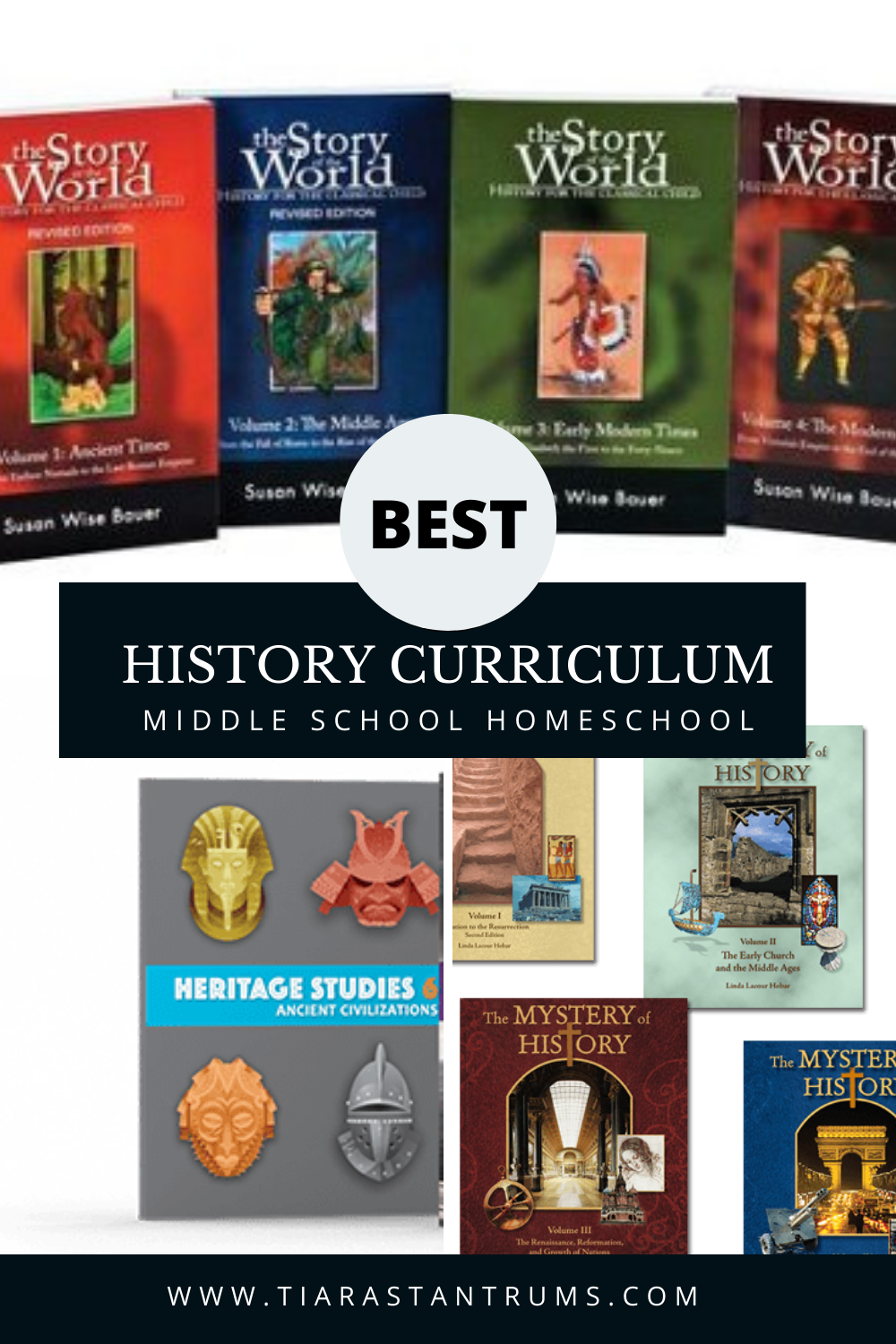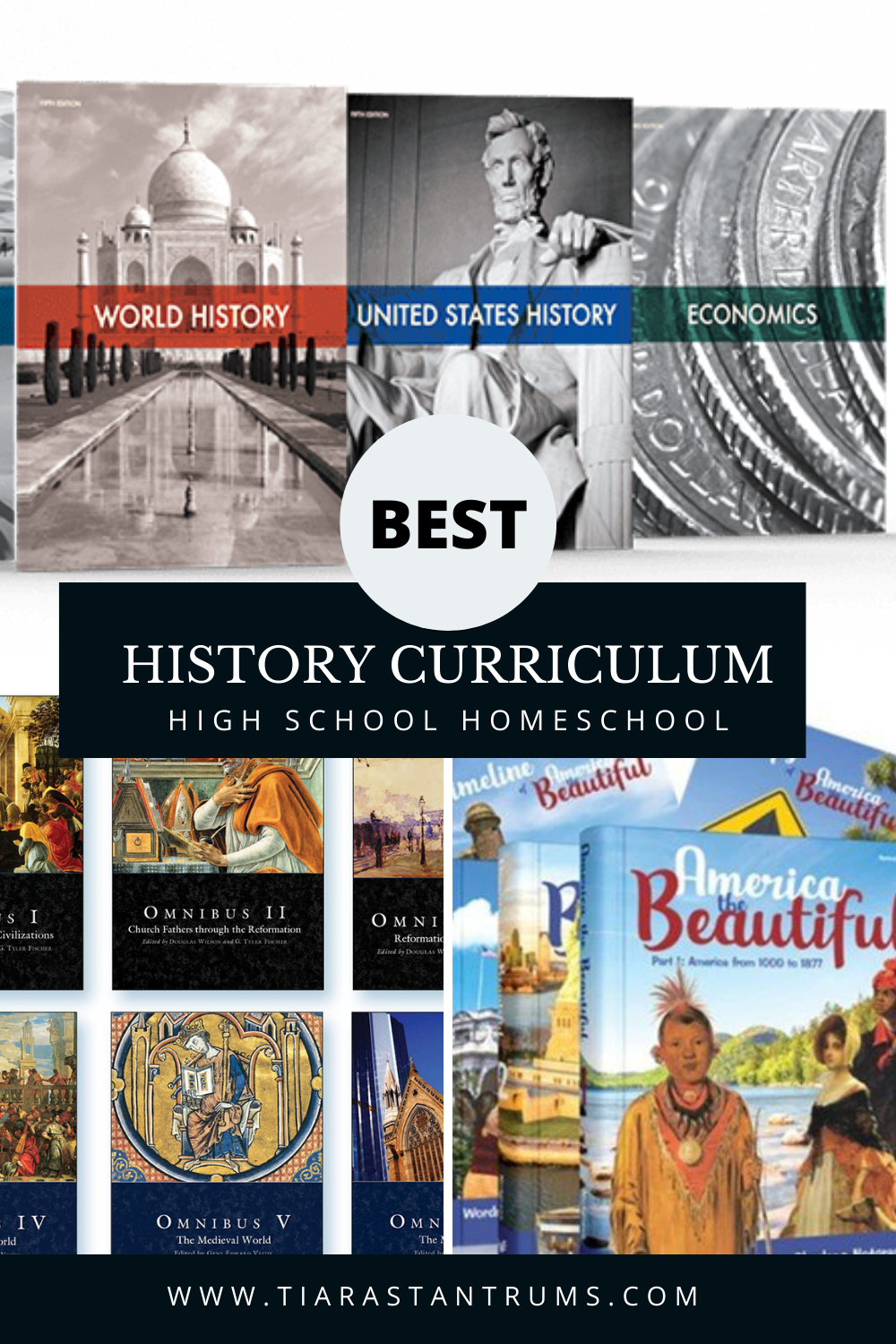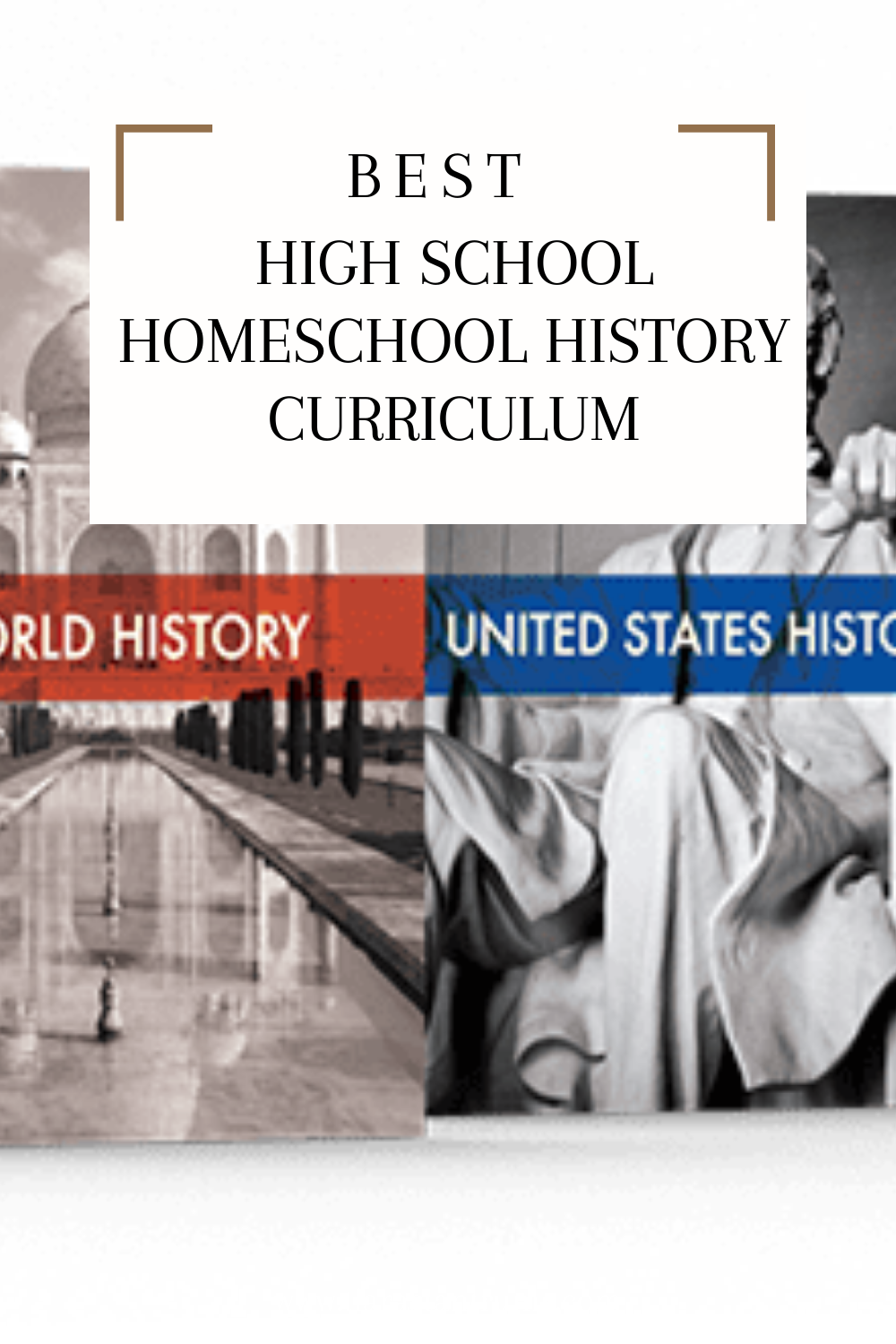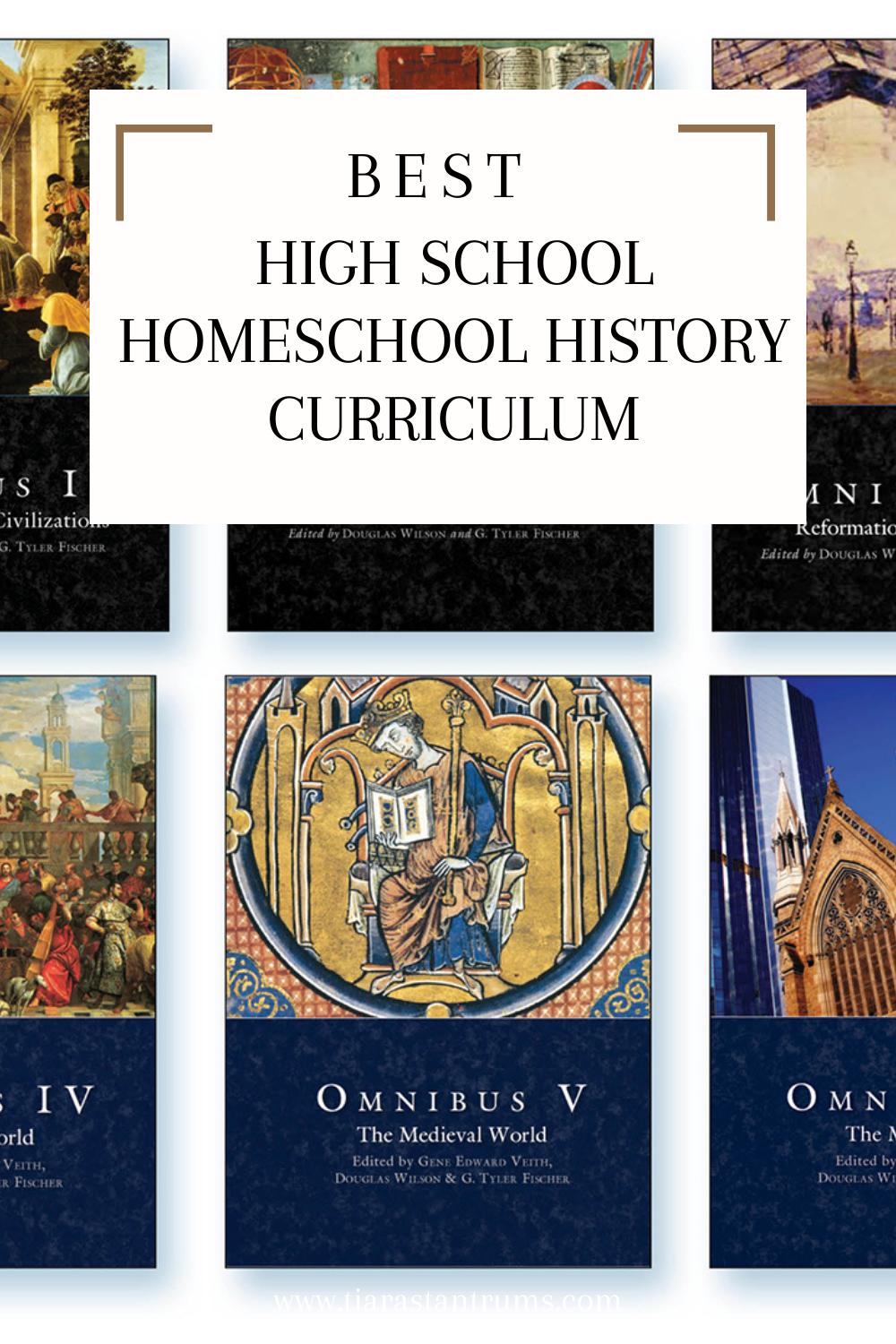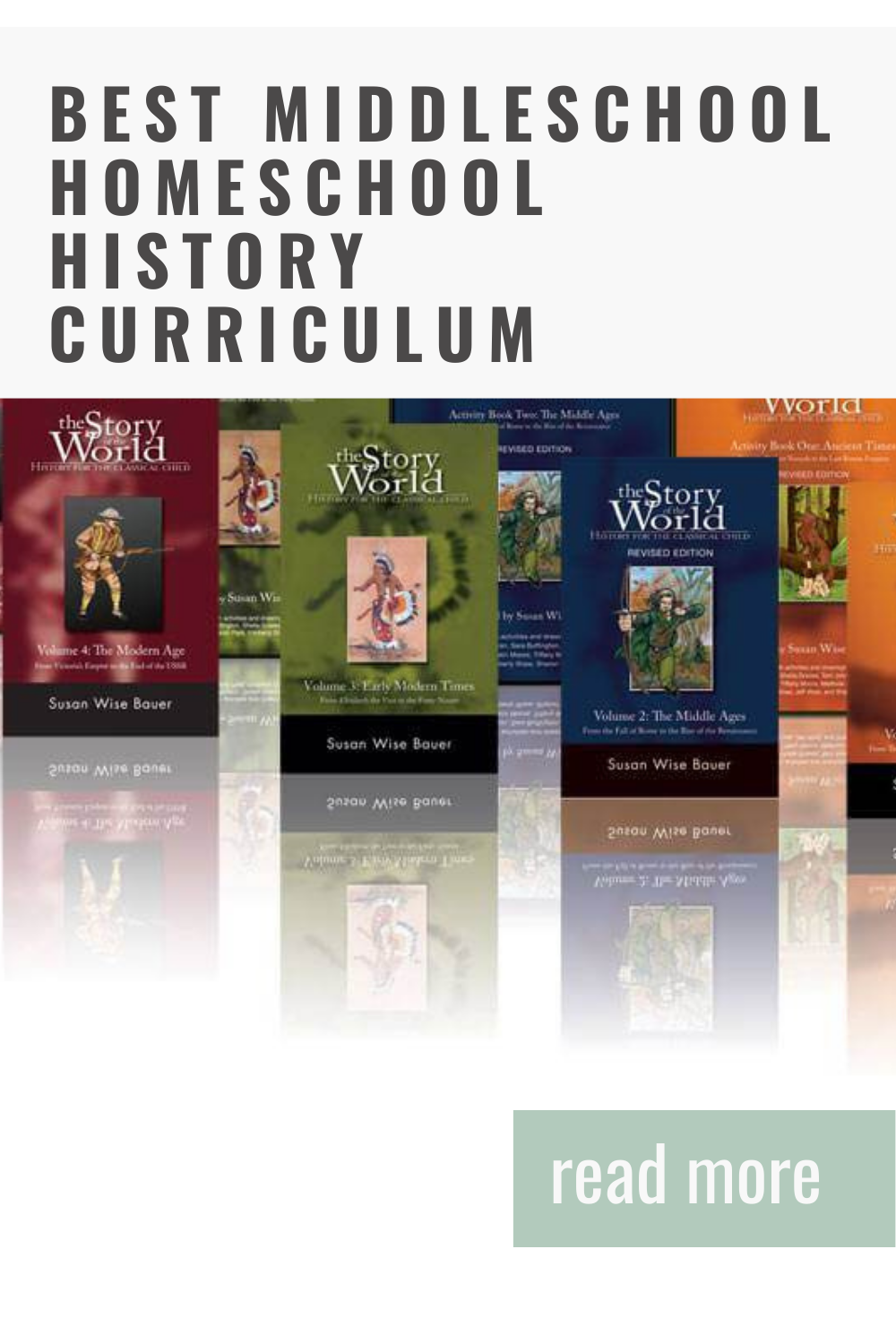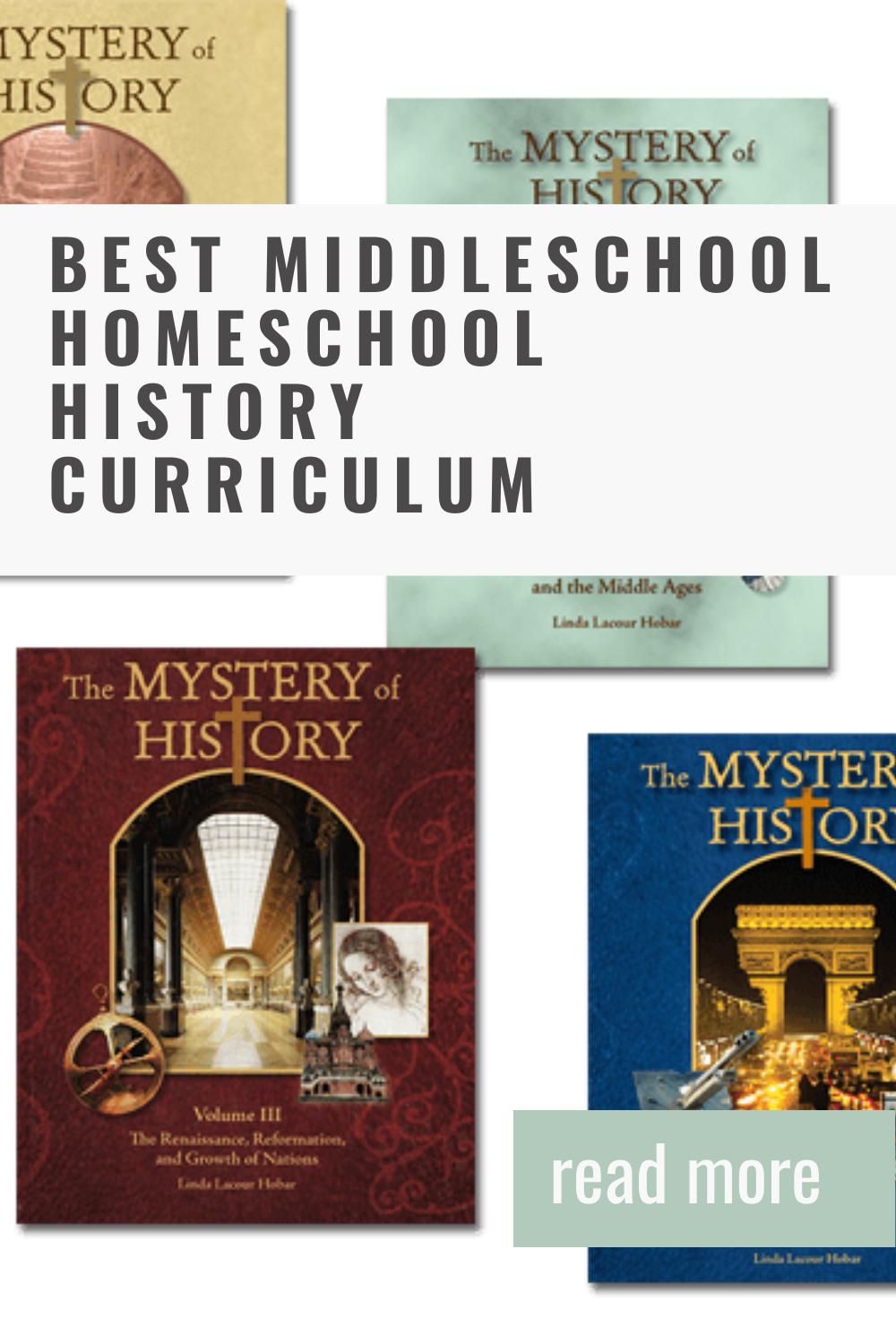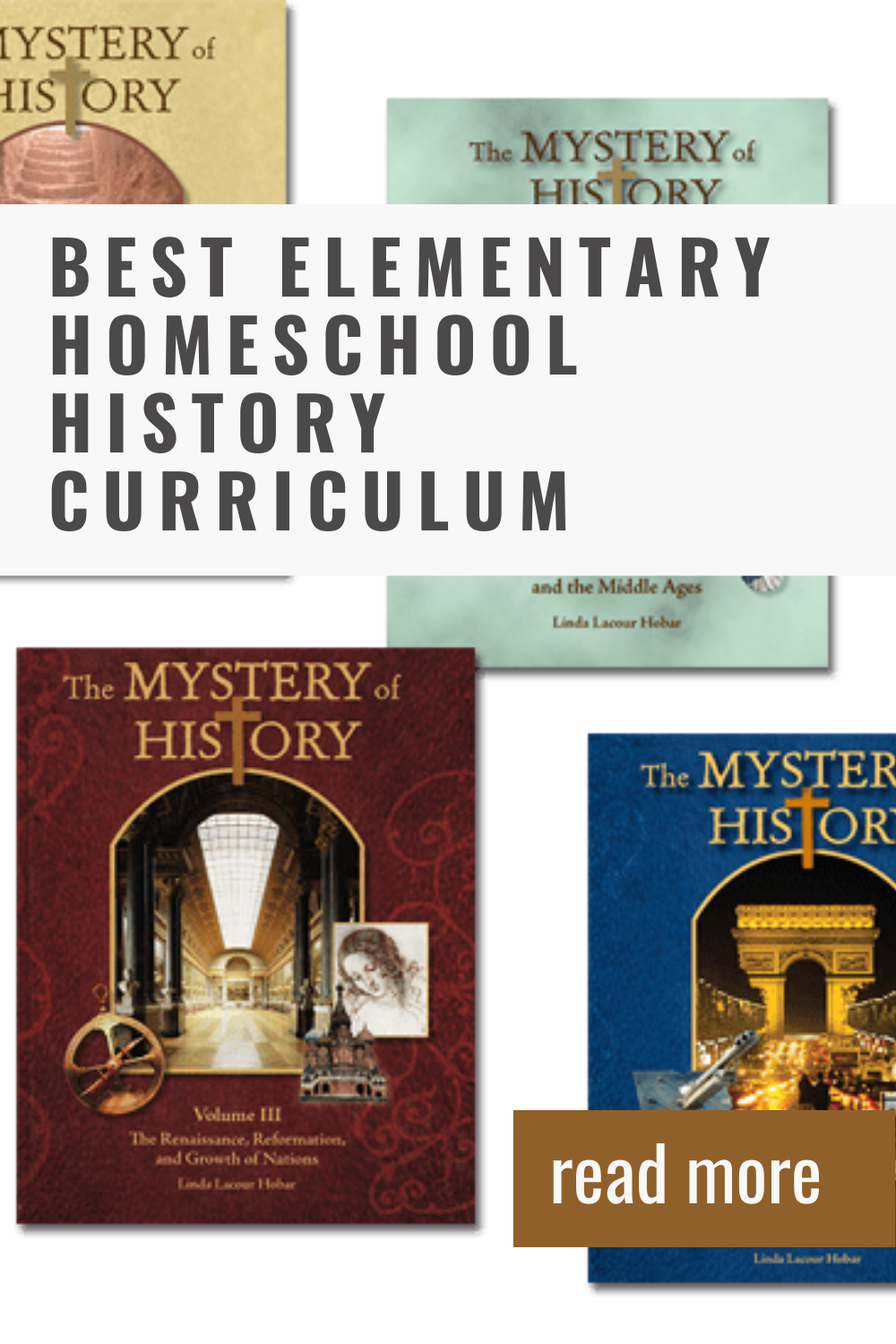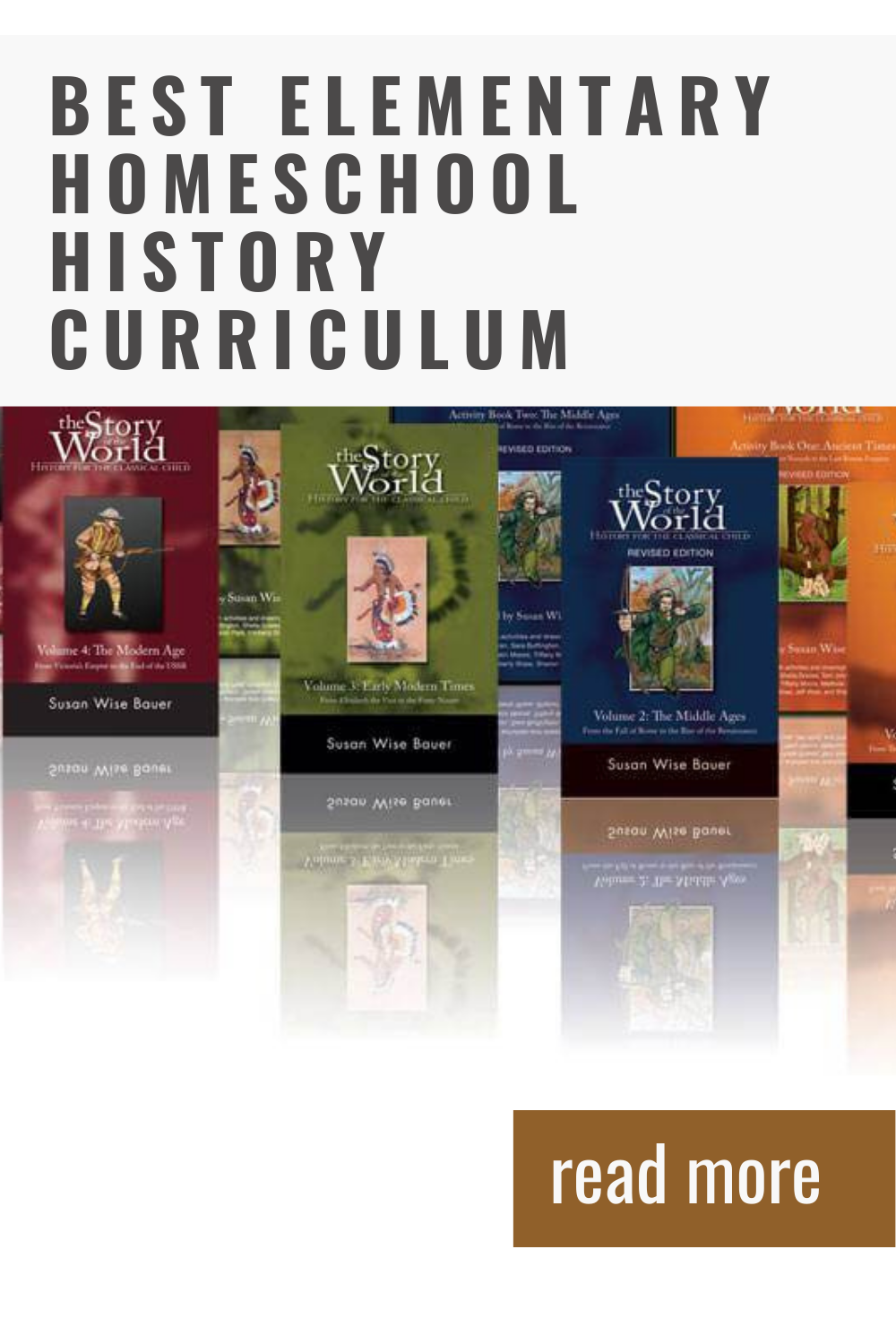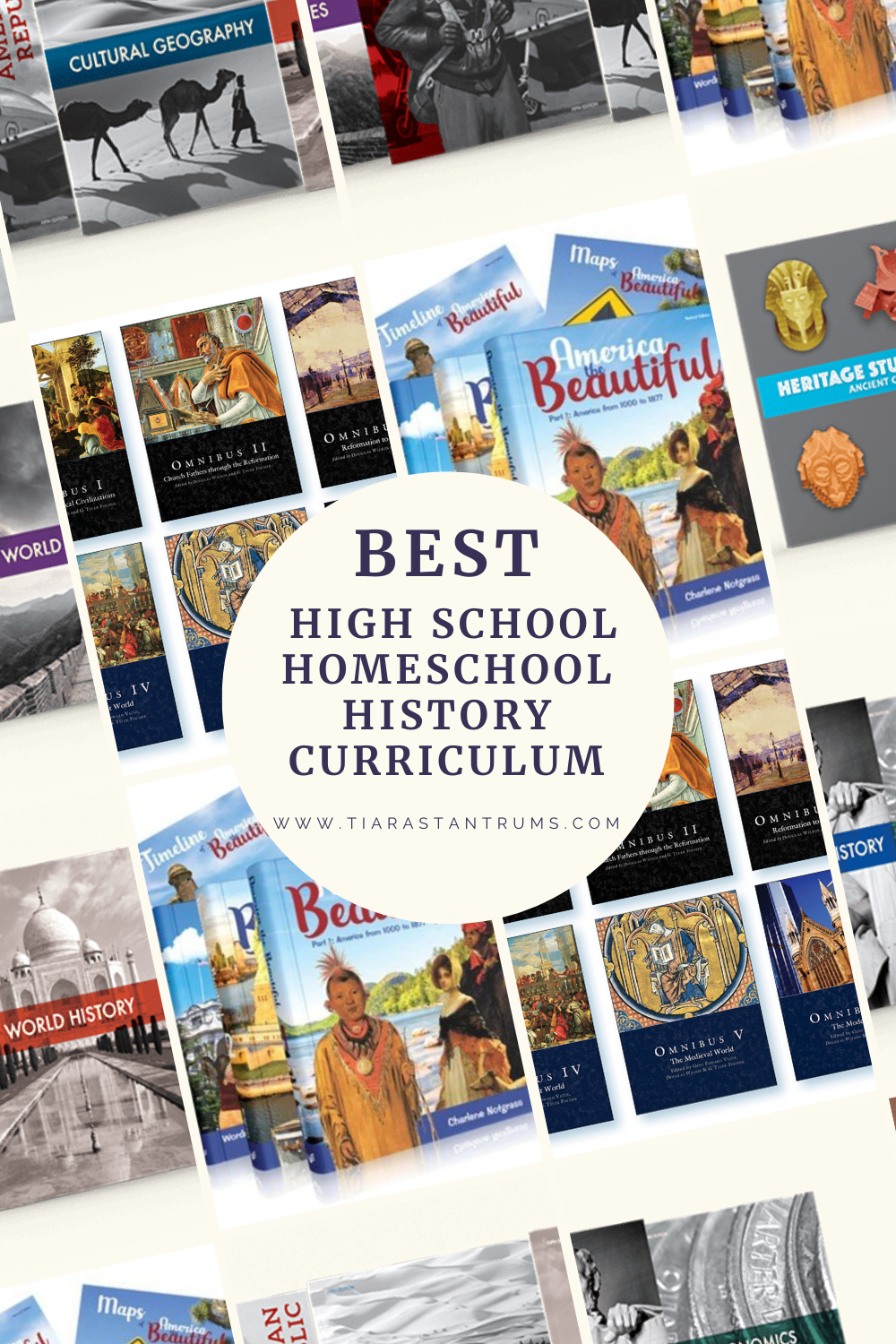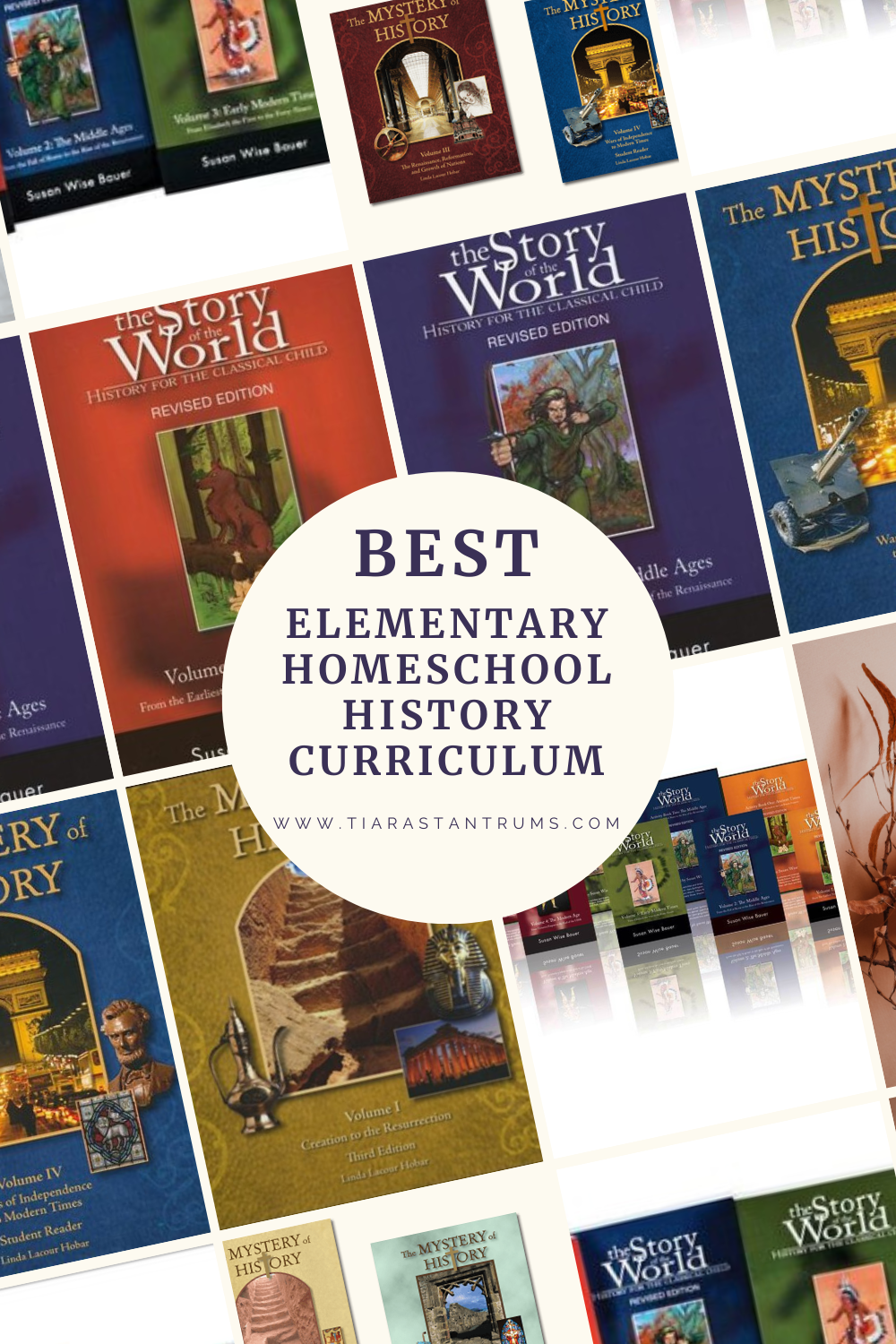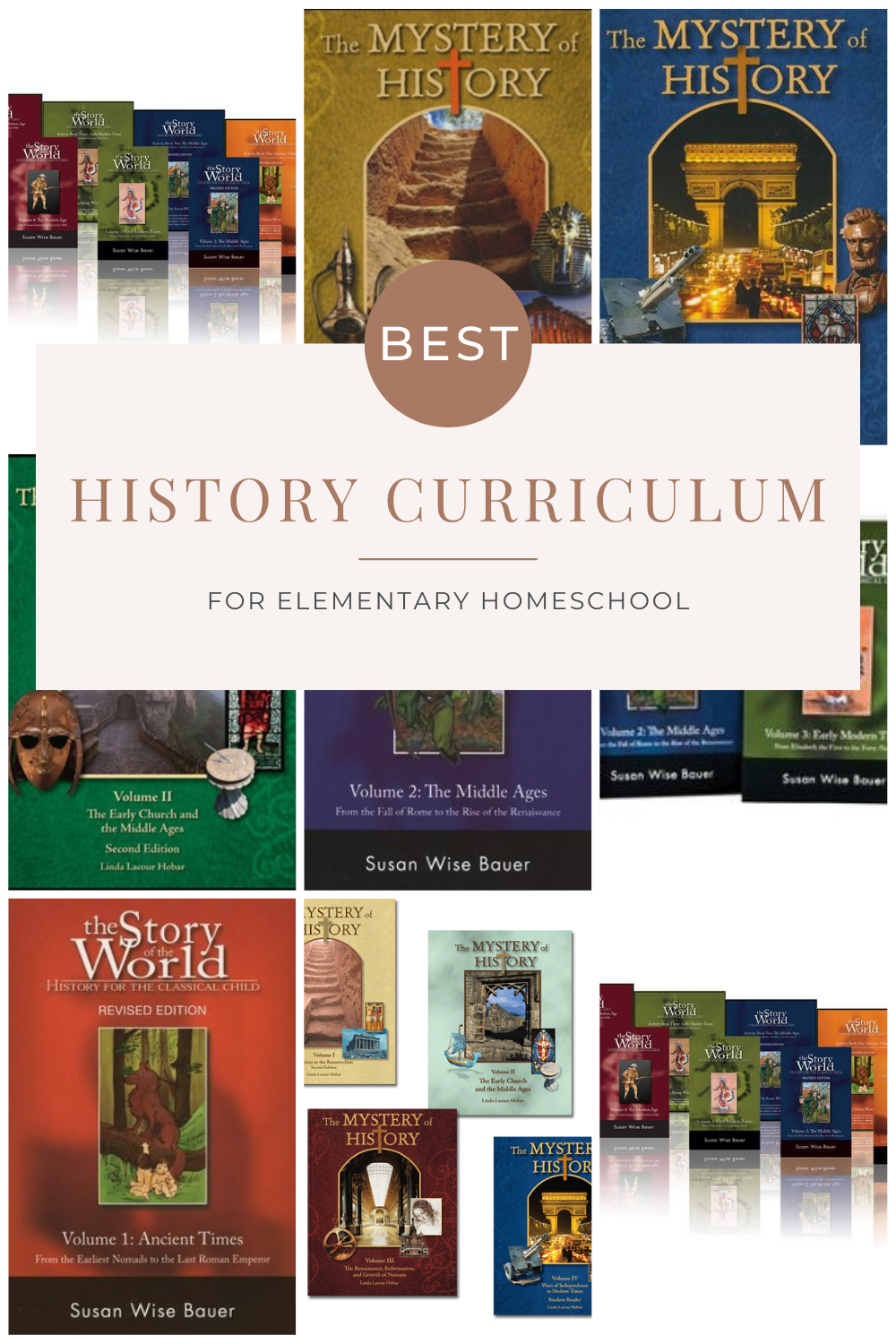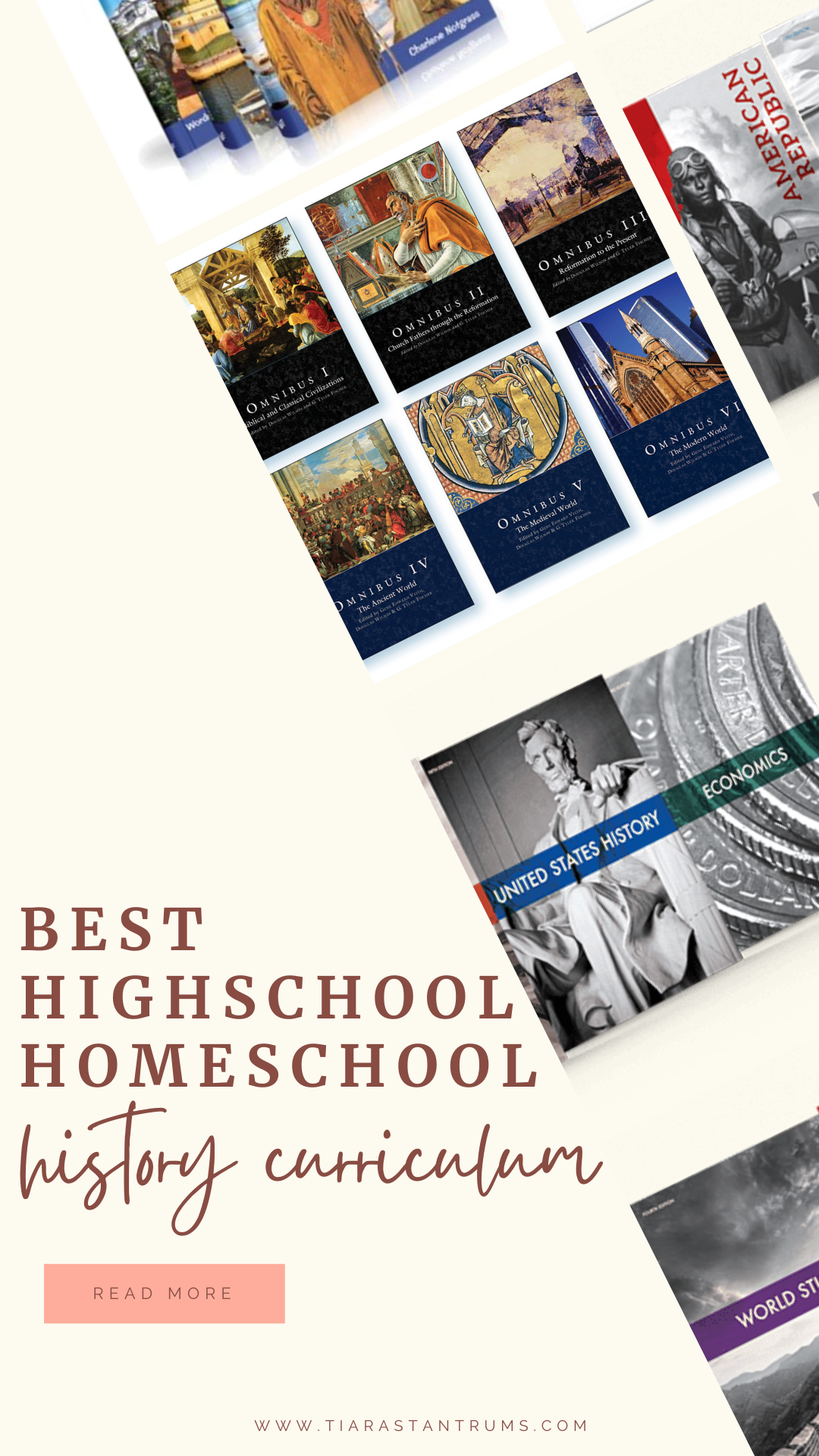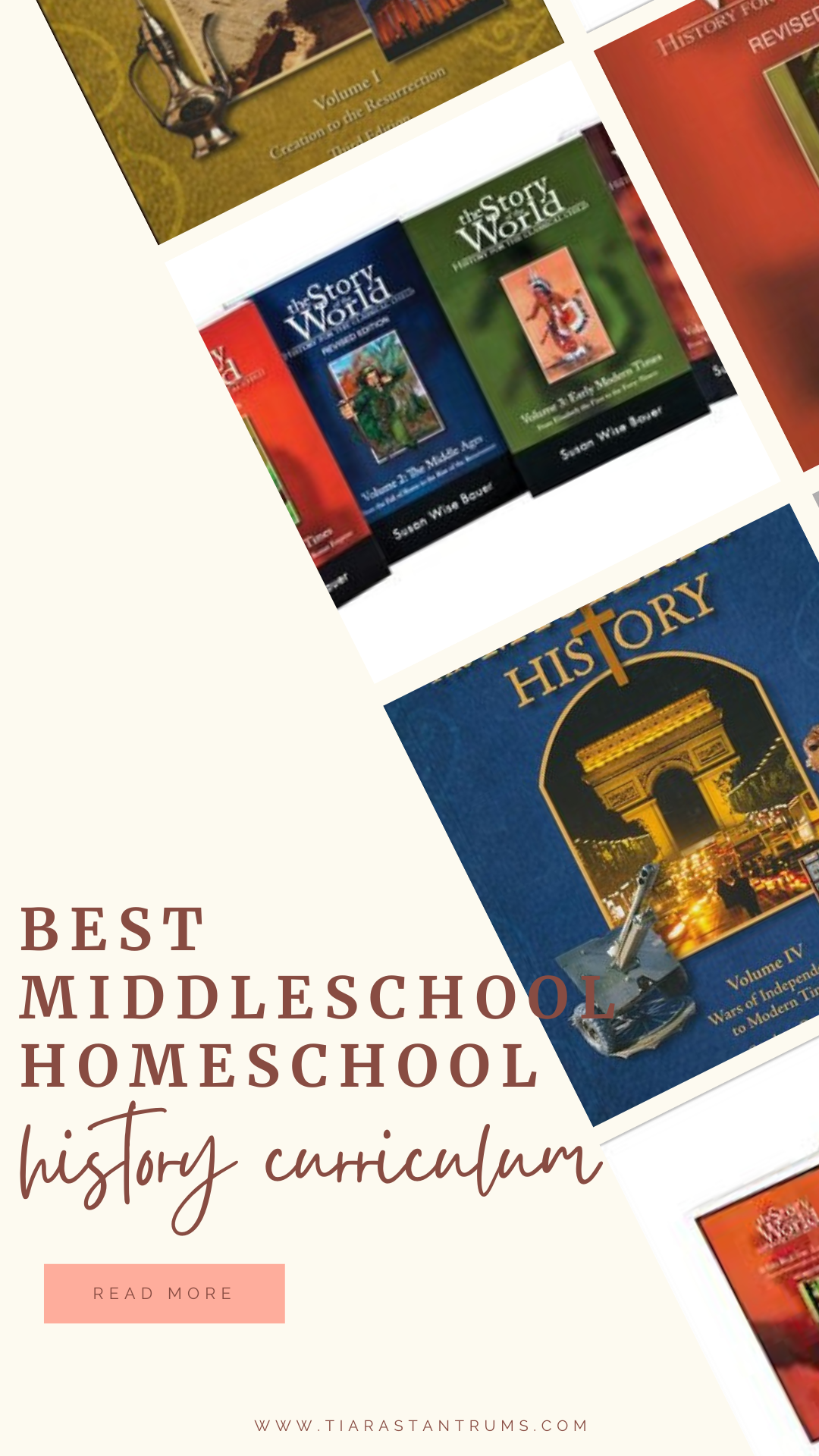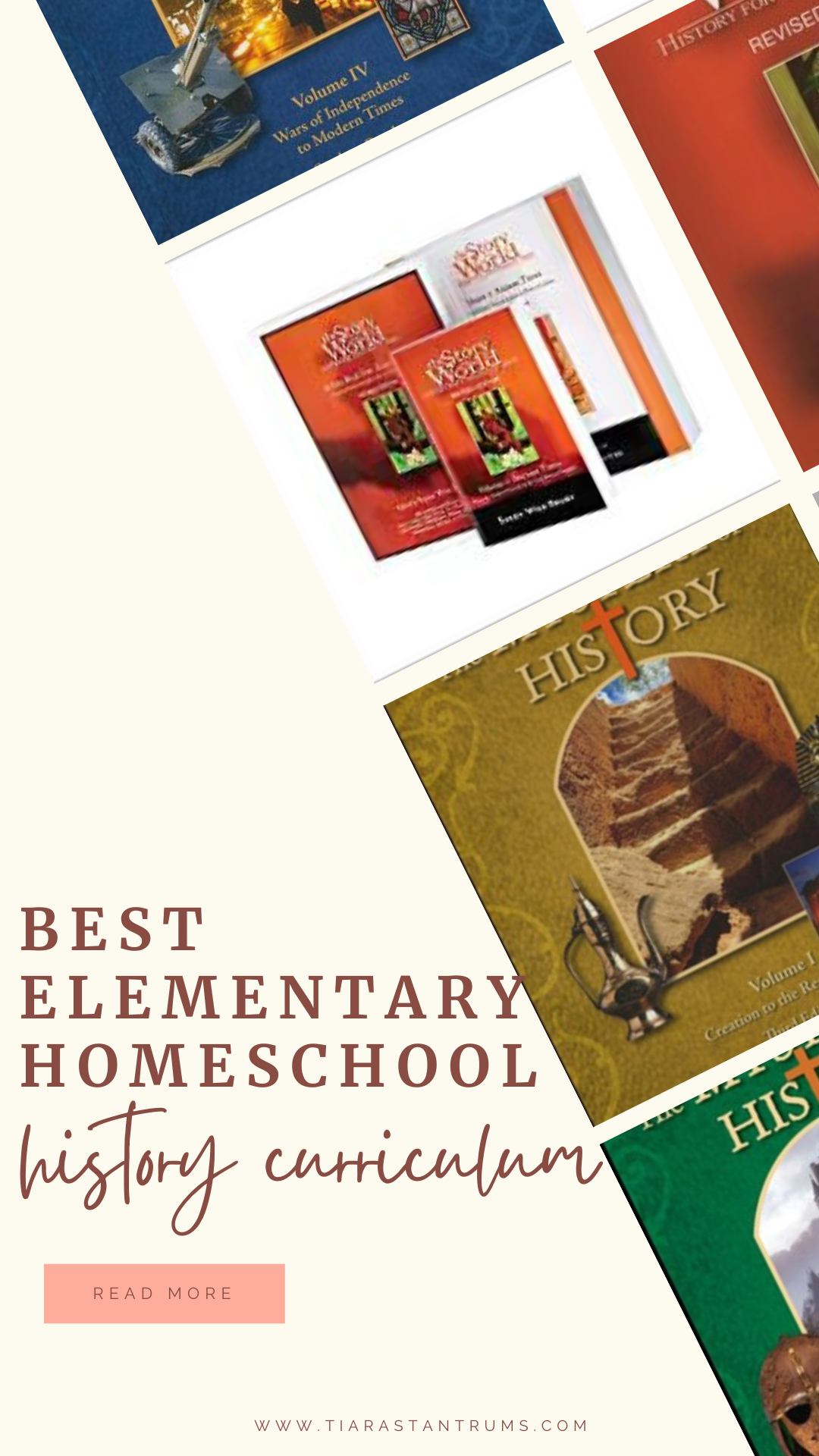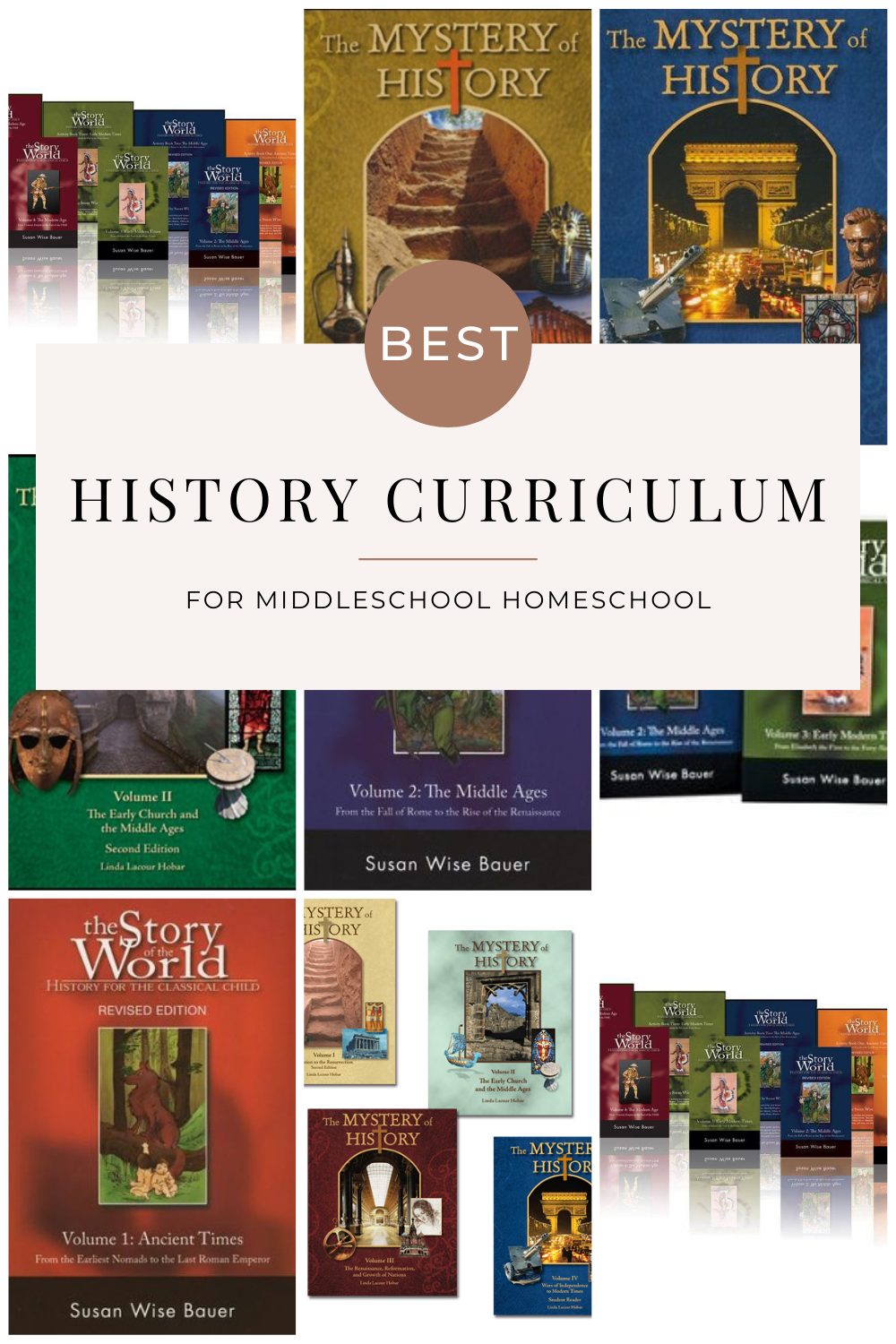The Best Homeschool History Curriculum
The best homeschool history curriculum for elementary and middle school home-educated students and my top picks to use in your homeschool classroom. The needs of homeschool parents and students vary widely and there simply is not a single “best” history curriculum for everyone or every family since everyone is so different. Selecting the best homeschool history curriculum is going to be a difficult task, but I can only speak about our favorites and our most used and loved history curricula that may help you on your research for your family and homeschool journey.
This post may contain affiliate links. Please see my full disclosure policy.
Teaching History / Omnibus, {eg: Social Studies} to Elementary students is probably one of my favorite subjects to teach. Teaching Omnibus is the classical Christian educational approach by teaching history, theology, and literature together. Omnibus is a Latin term meaning all-encompassing.
BEST ELEMENTARY HOMESCHOOL HISTORY CURRICULUM
Why is Social Studies (eg: History) so boring? It's NOT boring! History has traditionally been taught in a boring manner. Do you recall your History teacher? Did he inspire you? Mine certainly did not and I can be completely honest and state that I didn't even realize I really LOVED History until I started teaching it to my own children.
Our first History home school curriculum, for Kindergarten, 1st grade and 2nd grade, we used Story of the World and Mystery of History. I know it may seem strange to use two History curriculum in the same years simultaneously, but my kids and I discovered that we love history. Like, LOVE, LOVE, LOVE history. Our main curriculum was the Story of the World and the supplemental was the MOH for the first year. (My kids were in 4th, 2nd and Kindergarten the first year of home educating and 5th, 3rd and 1st grades the second year of home educating).
Since my approach to teaching History is the Omnibus approach, I taught History and Geography together and our Biblical Studies correlated to our timeline as well. In addition, I selected Literature that also matched the lessons we were studying in History as well as creating art projects that were right inline with the history lessons of the week. Do not be intimidated by this at all. Teaching History does not have match the classical approach at all.
The SOTW and MOH curriculum are great enough they can be used as stand alone subjects. I used SOTW for my daughters, but my son listened and sometimes participated in the projects. My son's curriculum was MOH and my daughters listened, but did not do the worksheets the first year. All the kiddos participated in verbal queries, activities and projects.
The Story of the World
Each Story of the World volume text book (there are four) provides a full year of history study which can be combined with the separately purchasable Activity Book, Audiobook, and Test book. The Story of the World Text Book is recommended for Grades 1-5. SOTW includes four complete years of history, geography, and literature study–a full elementary program!
Volume One: Ancient Times: from the Earliest Nomads to the Last Roman Emperor: This first volume brings to life the ancient civilizations of Sumer, China, Egypt, Mohenjo-Daro, Greece, Persia, Rome, and more. Includes the author’s retelling of the great myths and religions of each culture. Maps, timelines, and illustrations provide context and detail.
Volume Two: The Middle Ages: from the Fall of Rome to the Rise of the Renaissance: Knights and castles; the Maya and the Aztecs; the rise of Islam and the Crusades; Joan of Arc, Mansa Musa, Galileo, Martin Luther, and Magellan. This volume is jam-packed with unforgettable characters and stories. Includes illustrations, maps, timelines, and a pronunciation guide.
Volume Three: Early Modern Times: from Elizabeth the First to the Forty-Niners: Clearly and grippingly narrates the exploration and colonization of the Americas, including the Native American response to the newcomers; the Scientific Revolution in Europe; the birth and expansion of the United States, slavery and the efforts to end it; and much more. Includes maps and illustrations.
Volume Four: The Modern Age: from Victoria’s Empire to the End of the USSR: The final volume helps readers understand the American Civil War, the rapid growth of technologies such as the railroad and electricity; new movements for freedom in Africa and Asia; the Space Race; the Cold War and its conclusion, and people as varied as Gandhi, Hitler, Evita Peron, and Martin Luther King. Includes maps and illustrations.
I did not utilize the audiobook, but I did purchase the test books (for books 1 & 2). I also created my own tests for my children and I read them each day to the kids. (You will want to read this text because it is SO interesting). But, if you are traveling to activities during the day and have long drives, I can see the audiobook as a helpful aid.
I did purchase the Activity Book for Vol 1 & Activity Book Vol 2 and utilized a lot of the book, but certainly not every page or activity. Later years, when we came back to SOTW in middle school, I purchased the activity books for Activity Book Vol 3 and Activity Book Vol 4 as well. There is a large selection and I was also using MOH. The maps are great and the review pages are also amazing. I didn't have my children complete all the coloring sheets, because coloring is not their favorite activity.
When I was teaching from SOTW Vol 1, my kids also created a lapbook. The lapbook was created by Alica Heise who used to blog at Run of the Mill Family. These lapbook pages are no longer available from her as she no longer blogs. If you would like the lapbook pages, please email me and I will send them to you since I can’t post her pages on my site. Or you can also do a google search as other homeschool moms have them as well. We really enjoyed the lapbook exercises. My two youngest created the lapbook and completed these activities and projects and my 4th grader did not.
Mystery of History
Mystery of History employs a classical (using rhetorical teaching techniques), chronological (instead of thematic) and Christian approach to teaching history. The Mystery of History is written from a Christian, young-earth, perspective, teaching children to see God’s hand throughout history. MOH is written in a conversational style, and many lessons are presented in the form of mini-biographies, tying in fascinating stories with the events of the time.
Mystery of History Volume I - Creation to the Resurrection: This volume covers world history from Creation to the death and resurrection of Jesus Christ. The text spans the incredible stories of ancient times, ancient lands, and ancient peoples.
Mystery of History Volume II - The Early Church and the Middle Ages: Volume II expands on the fall of the Roman Empire and the Dark Ages that followed. Delve into the chivalry of knights and damsels, kings, and queens, and the peasants who faithfully served them. Students visit Vikings and villains; castles and crusades; and the poetry of Dante and Chaucer.
Mystery of History Volume III - The Renaissance, Reformation, and Growth of Nations: Volume III will look at what was going on all over the world in the order that it happened. While the Renaissance and Reformation were taking shape in Europe, students will look at the rise of wealthy empires in West Africa; the Mogul dynasty of India; and the peaceful lives of the Aboriginals of Australia. We will also visit Ivan the Terrible in Russia and the Tokugawa family in Japan.
Mystery of History Volume IV - Wars of Independence to Modern Times: Volume IV, the last and final volume of this world history series, spans three pressure-filled centuries from 1708 to 2014. Starting with Bach and Handel, two of four major composers included in Volume IV, the time period will see numerous “wars of independence.” From the American colonies, the heart of Mexico, the gold mines of Australia, the mountaintops of South America, the shores of Greece, and the walls of the Alamo, we will find mankind desperately striving for liberty and freedom through the eighteenth and nineteenth centuries.
Arranged by quarters and weeks, each quarter begins with an “Around the World” summary of events to introduce the time period; lessons progress chronologically with each week having three lessons, a pretest, review, and an exercise or quiz. The 108 lessons will take a year to complete if you follow a traditional 36-week school year.
The Lesson Activities are partitioned by age group (younger, middle, and older students) and reinforce the material just learned through fun activities and projects that engage all learning styles. These projects and activities are based on the classical grammar/logic/rhetoric stages.
The review exercises review the timeline and map work exercises. The quizzes are cumulative reviews that cover material from the previous lessons. The semester-long tests are similar, reviewing materials from the previous lessons. The suggested schedules in MOH for different age groups are included, as well as a variety of reproducible(s). The answer to all reviews, pretests, quizzes, and tests are included.
Also available for additional purchase is The Mystery of History Volume I Companion Guide. I have the actual printed guidebook, but I think this is only available on CD or download now. This PDF file includes everything from the print edition of the book except the lesson text (which needs to be purchased separately). Inside are various activities, teaching prompts, and reproducible(s), organized by lesson numbers. There are also coloring pages, notebooking pages, Challenge Cards, grading aides, folder books, a supplemental book list, a Bible reading list, answer keys, and more included in the companion guide!
The Companion Guide contains:
Quarter Summaries
Pretests
Instructions for making timelines, memory cards, and a history notebook
Map work
Quarterly worksheets
Quizzes and semester tests
Answer keys
Supplemental reading/video list
Extra activities and instructions for using The Mystery of History for high school students to gain a high school history credit
Now, the MOH volumes progress in history, and the volumes also progress in content and level of rigor. The assumption is that you will progress through the volumes as your children progress through school. The suggested grades for MOH are grades 4-8, which I agree with. The author explains very well in the introduction of MOH how best to utilize the textbooks. The lessons are very well written and activities well planned. The MOH texts are easy to understand and intuitive and the learning curve is minimal. The resources included in MOH are quite beneficial and the time it takes to complete a lesson each day with your children is practical and realistic.
I do want to point out that based on your own family's morals, ideals and values, I suggest reading the material prior to your lessons. There are some lessons that contain information that you may not want to read to your children, teach to your children, or may not even be reading to discuss based on the age of your children. If there is material included that I do not want to teach, I simply do not read these sections. I have actually gone as far as to black out the sentences I don't want my children to read.
SUPPLEMENTAL MATERIALS
In order to teach History effectively, I suggest supplementals as well. I have a couple of globes in our classroom. I have various maps all over the classroom too. In addition, I have the following books in our homeschool library. I didn't purchase all of these books all at once. These are books I have collected over the many years of home-educating my children.
Map Trek The Complete Collection (really a fantastic full set of maps)
Veritas Press History Cards Set of 5:
Veritas Press History Cards: Old Testament and Ancient Egypt,
Veritas Press History Cards: Explorers to 1815,
Veritas Press History Cards: New Testament, Greece, and Rome,
Veritas Press History Cards: 1815 to Present Monroe Doctrine to Present Day America, and
Veritas Press History Cards: Middle Ages, Renaissance, and Reformation.
National Geographic Atlas of the World (this book is huge)
National Geographic Kids books - Various(too many to choose)
A History of US, Third Edition: 11 Volumes (I can’t tell you how many times my kids have used these books over the years - even in the early college years!! - SO USEFUL)
A History of US: Book 1: The First Americans Prehistory-1600
A History of US: Book 2: Making Thirteen Colonies
A History of US: Book 3: From Colonies to Country: 1735-1791
A History of US: Book 4: The New Nation: 1789-1850
A History of US: Book 5: Liberty for All?: 1820-1860
A History of US: Book 6: War, Terrible War 1855-1865
A History of US: Book 7: Reconstructing America: 1865-1890
A History of US: Book 8: An Age of Extremes
A History of US: Book 9: War, Peace, and All That Jazz 1918-1945
DY Eyewitness Books - Various (so many great books)
The World Reference Maps & Forms (Evan Moor)
Various World Maps & a Globe
The Getting to Know the U.S. Presidents (book series by Mike Venezia)
You can certainly teach MOH as it is laid out in the textbook, utilizing all the supplemental materials from the companion guide and the notebooking pages, which we did use and are quite helpful for teaching note-taking (an essential skill to teach your children). However, I didn't like the pretest, quizzes, or tests that were included, so I created my own curriculum (daily worksheets for each lesson, quizzes, and tests) to go along with each volume of MOH. There are a number of sites that offer free downloads as well. BibleStoryPrintables.com has an entire set of notebooking pages that coincide with Volume 1. I have created some amazing timeline binder printables for all MOH volumes that are available on my free printables page. In addition, I have also created an incredible set of downloadable notebooking pages AND Omnibus Volume 1 timeline figures!!
BEST MIDDLE SCHOOL HOMESCHOOL HISTORY CURRICULUM
Since both MOH and SOTW are recommended through grade 8, I would say, these two are my top favorite picks for teaching History to Middle School students. I have also used another curriculum, but it is a rigorous curriculum. So if you don’t want rigorous, stick with MOH and SOTW or you can switch gears and head to BJU History curriculum, which I also really like (we used it for middle school and high school as well). If you do not enjoy history or your child does not enjoy history, I would not recommend using Omnibus by Veritas Press until high school (or even at all since it is rigorous). It is recommended to begin Omnibus I Primary in grade 7 but can be started in 9th grade.
SKIP DOWN TO READ ABOUT OTHER CURRICULUM
Omnibus is truly taught by combining history, theology, and literature. These particular texts really help students grow in appreciation of the unity of all knowledge. Each year offers two courses; the primary books course and the course of the secondary book. They can be taken separately, but taken together, students earn three credits—history, theology, and literature.
Omnibus I and Omnibus II Primary texts are taught from a Biblical viewpoint, so keep this in mind. Completing Omnibus I will provide full high school credit in Ancient World History I, one in Doctrine and Theology I, and one in Ancient Literature I. Diploma students completing the course will be given a credit in English: World Ancient Literature I. When combined with Omnibus I Primary Books, Diploma students will be given three credits, History: World Ancient History I, English: World Ancient Literature I, and Religion: Doctrine and Theology I. The text assigns the readings in the primary and secondary books for each semester. Homework will average 4 - 5 hours per week, depending on reading speed.
This daily approach includes lesson plans and will make teaching and interacting with the greatest works of Western civilization both enjoyable and profitable. Students will also apply and further develop their skills in composition, logic, and aesthetics. Students completing all six years of Omnibus will have carefully studied every book of the Bible too.
Omnibus I is a unique course covering topics in literature, history, and theology from the Reformation to the present. The goal of this course is to help students think critically and biblically about the events and ideas presented in the reading material. Students should learn to see how ideas that have shaped the past continue to influence the present. In other words, ancient ideas, philosophies, and religious beliefs are not isolated in history. The consequences of these ideologies continue to exist in contemporary thought. Students will also be expected to evaluate the Great Works of literature in light of God’s Word, learning to defend the truths of Christianity against false thinking. Additionally, students will apply and hone their skills in composition, logic, and aesthetics.
The recommended reading books to go along with the Omnibus text for Omnibus I and II are available at Veritas Press. I did not assign all this reading to my middle school students. As a parent, I knew the challenges of this course and I also knew my children's strengths. If you have voracious readers, enjoy the full reading list.
I read with or to or listened to my children read or pre-read these books. Your kids may fall in love with some of the books, dislike others, and discover favorites – this is all part of learning great classic books. Middle School students may find themselves struggling to understand some of the books – this is very normal. Just like learning a foreign language, comprehending historical works takes time and self-discipline. Reading skills are like a muscle and will get stronger as they are used. Have your middle schoolers focus on grabbing the big ideas, and asking loads of questions.
Here are the books I assigned for Omnibus I (ancient):
Till We Have Faces by CS Lewis
Epic of Gilgamesh by David Ferry
Codes of Hammurabi and Moses by Davies
Odyssey of Homer by R. Lattimore
The Landmark Herodotus by Strassler
Plutarch's Lives Vol. 1 by Arthur Clough
Screwtape Letters by C.S. Lewis
Chronicles of Narnia: Magician's Nephew
Voyage of the Dawn Treader or The Last Battle
Theban Plays by Sophocles
Last Days of Socrates by Plato
Early History of Rome by Livy
Aeneid by Virgil
Twelve Caesars by Suetonius
Julius Caesar by William Shakespeare
Here are the books I assigned for Omnibus II (Medieval):
The Church History by Eusebius
Confessions by St. Augustine
The Nine Tailors by Dorothy Sayers
On the Incarnation by Athanasius
The Ecclesiastical History of the English Peoples by Bede
The Rule of St. Benedict
Beowulf
Song of Roland
Macbeth by Shakespeare
Sir Gawain and the Green Knight
Divine Comedy – Inferno by Dante Alighieri
Canterbury Tales by Geoffrey Chaucer
Bondage of the Will by Martin Luther
Merry Adventures of Robin Hood by Howard Pyle
Henry V by Shakespeare OR Midsummer Night's Dream by Shakespeare
BEST HIGH SCHOOL HOMESCHOOL HISTORY CURRICULUM
If you continue with the Omnibus curriculum through high school for History, the next class is Omnibus III. Given the nature of some mature content in these works, it is important for parents to have an open dialogue in the home about the readings. Families may have differing perspectives on what is age-appropriate for their students. As parents, we know our children best and can select to edit a reading if needed. Again, I do not have my children read every single recommended reading book.
NOW IF YOU DO NOT WANT TO CONTINUE WITH THIS OMNIBUS CURRICULUM — SKIP DOWN TO THE NEXT SECTION
Omnibus
Omnibus I: Biblical and Classical Civilizations | Ancient (7th Grade)
Omnibus II: Church Fathers Through Reformation | Medieval (8th Grade)
Omnibus III: Reformation to the Present | Modern (9th Grade)
Omnibus IV: The Ancient World | Ancient (10th Grade)
Omnibus V: The Medieval World | Medieval (11th Grade)
Omnibus VI: The Modern World | Modern (12th Grade)
Omnibus I: Biblical and Classical Civilizations: The student text leads the student through the study of the great works from the dawn of time to the fall of Rome; teaching with an emphasis on ideas, not simply information.
Omnibus II: Church Fathers Through Reformation: The student text leads the student through the study of the great works from the medieval world beginning with Eusebius and ending with Luther; teaching with an emphasis on ideas, not simply information.
Omnibus III: Reformation to the Present: The student text leads the student through the study of the great works from just after the Reformation and covers significant works of modern Western culture; teaching with an emphasis on ideas, not simply information.
Omnibus IV: The Ancient World: The student text leads the student through the study of the great works focusing on great works of the ancient world, culminating in the first century; teaching with an emphasis on ideas, not simply information.
Omnibus V: The Medieval World: The student text leads the student through the study of the great works focusing on great works of theology, history and literature of the medieval world beginning with the works of St. Augustine and ending in the Reformation era; teaching with the emphasis on ideas, not simply information.
Omnibus VI: The Modern World: The student text focuses on great works beginning just after the Reformation and covers significant works of modern Western culture; teaching with an emphasis on ideas, not simply information.
Here are the books I recommend for Omnibus III:
Pilgrim's Progress by John Bunyan
Westminster Confession of Faith
Of Plymouth Plantation
Frankenstein by Mary Shelley
The Social Contract by Jean-Jacques Rousseau
Foundational American Documents
Federalist Papers by Alexander Hamilton
Anti-Federalist Papers by Ralph Ketcham
Tale of Two Cities by Charles Dickens
Uncle Tom's Cabin by Harriet Beacher Stowe
Slave Narratives
Lincoln's Speeches
Communist Manifesto by Karl Marx
Animal Farm by George Orwell
The Great Gatsby by F. Scott Fitzgerald
Mein Kampf by Adolf Hitler
Nineteen Eighty-Four by George Orwell
Omnibus IV is the next level class in this series and by this time, students will have mastery of the following objectives.
Think biblically about ideas
Understand and recognize the consequences of ideas
Be able to evaluate a work of literature or art within its historical context
Be able to evaluate a work of literature or art in light of Scriptural truth.
Demonstrate clear and logical thinking both orally and in writing
Recognize God’s sovereign hand in history
Gain confidence in defending Christianity against false thinking
Iliad
Landmark Thucydides
Bacchae
Republic
Nichomachean Ethics
Rhetoric and Poetics of Aristotle
Euclid’s Elements
The War with Hannibal
On the Nature of Things
Cicero: Selected Works
Annals of Imperial Rome
Metamorphoses
Josephus: The Essential Writings
Meditations, Marcus Aurelius
Desiring God
Turabian: The Easy Way
Omnibus V: Student Text + Primary Book Set: First Semester and Second Semester: This will be the final text in the Omnibus series that I recommend. There is one more level, Omnibus VI.
If the Omnibus Series gets to be too much reading or it just doesn't fit with your home educating plan or student, here are some other recommendations.
Now, in order to add Omnibus to High School transcripts, the course name will need to change since colleges don’t know what Omnibus is. One full year of Omnibus equals THREE FULL courses - 9 FULL CREDITS! If you choose a condensed version, the Omnibus courses will only be worth 6 credits for high school transcripts.
Omnibus I: World Ancient History I& Theology I & World Ancient Literature I
Omnibus II World Medieval History I & Theology II & World Medieval Literature I
Omnibus III U.S., British & Modern History I & Theology III & U.S., British & Modern Literature I
Omnibus IV World Ancient History II & Theology IV & World Ancient Literature II
Omnibus V World Medieval History II & Theology V & World Medieval Literature II
Omnibus VI U.S., British & Modern History II & Theology VI & U.S., British & Modern Literature II
SKIP TO THIS SECTION TO UTILIZE OTHER HISTORY HIGH SCHOOL CURRICULUM
Economics (9th Grade) and American Government (Grade 9) OR Cultural Geography (Grade 9)
I know most high schools have students take Economics when in 12th grade, but I taught my daughters Economics in 9th grade (both of them, two different years) and it just seemed to work so much better with a smoother transition. However, swap the years as it fits your family!! Since I had my daughters take Economics in Grade 9, they took Cultural Geography in grade 8, but swap and trade as fit your family as I said before.
Economics: Students will be introduced to the key principles of economics, from household purchases to the stock market. Five units (15 chapters) ensure students gain a foundational understanding of economics as a science as well as the economics of countries, businesses, the financial markets, and the government.
American Government: The text aims to develop students' critical-thinking skills and demonstrates how knowledge of history and government are crucial for making decisions about issues on the local, state, and national levels.
Cultural Geography: Students travel around the world, starting with physical geography, the earth's climate, and the people of the world. The first four units progress from North and South America and then on to Europe and Russia. Unit five will cover Africa and then units six and seven will cover Asia. The book will conclude in unit eight with Oceania and Antarctica.
US History (10th Grade)
I used this textbook as well with both of my daughters, a gain two different years in 10th grade. Really straightforward curriculum that is all-inclusive if you purchase the entire package.
American History OTHER (11th Grade)
We live in a young country, but a country with a rich and impactful history. Understanding that history—its themes, conflicts, and the questions it raises—is fundamental to understanding our place in God’s story. The goal of this course is to give an overview of American history from the start to the current day, focusing on the major themes and issues, in order to better understand where we are and where we are going.
Exploring America: History, Literature, and Faith Volume 1, Ray Notgrass
Exploring America: History, Literature, and Faith Volume 2, Ray Notgrass
World History (12th Grade)
This student text includes numerous sidebars with intriguing bits of information, as well as full-color photographs of both modern areas and ancient artifacts. The seven units are divided into chapters (ranging from 2-6 per unit) that begin with a brief summary and timeline. Units cover the Ancient, Eastern, Medieval, Awakening, Enlightened, European, and Modern worlds. Activity pages, charts, timelines, maps, dates, and other features are also included throughout the student text.
WRAP UP
A homeschool history curriculum that works well in elementary school may not meet your needs as your children move on to middle school or even high school. I recommend sticking with a history curriculum that works for your family throughout the elementary grades and then evaluating if the middle school level curriculum will also meet your needs. I also suggest doing the same when your child moves on to high school.
This post may contain affiliate links. Please see my full disclosure policy.






